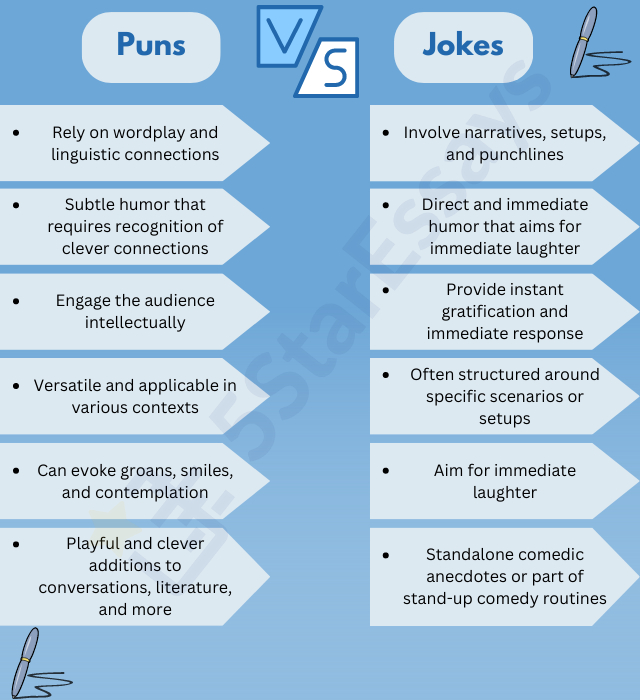What is a Pun?
“A pun is a clever play on words that creates humor by using words with multiple meanings or similar sounds.”
By deliberately using words that sound similar but have different meanings, puns create a humorous twist between seemingly unrelated ideas.
Puns can be found in various forms of writing, including jokes, riddles, poetry, and even serious literature.
Importance of Puns in Writing
Like other literary devices, puns play a crucial role in writing. They offer more than just a good laugh. Here are some reasons why are puns used in literature:
- Enhancing Engagement: Puns grab readers' attention with their clever wordplay, making the writing more interesting and enjoyable.
- Adding Depth: Puns bring multiple layers of meaning, making the writing more nuanced and sophisticated, especially for conveying complex ideas.
- Creating Memorable Moments: Puns leave a lasting impression, making the writing more impactful and memorable.
- Fostering Creativity: Puns encourage writers to think creatively, pushing the boundaries of language and showcasing their literary skills.
- Establishing Connection: Puns create a sense of camaraderie and connection between the writer and reader, fostering a positive rapport.
Exploring Different Types of Puns
Puns come in various forms, each with its own distinct flavor of wordplay.
In this section, we will delve into the world of puns and explore the different types.
Homophonic Puns
Homophonic puns rely on words that sound the same but have different meanings.
These puns play with the multiple interpretations of homophones, creating humorous and often unexpected connections.
"I used to be a baker, but I couldn't make enough dough."
(dough - referring to money or bread)
Homographic Puns
Homographic puns involve words that are spelled the same but have different meanings.
They capitalize on the ambiguity of homographs to create clever wordplay and humorous twists.
Homonymic Puns
"The roundest knight at King Arthur's round table was Sir Cumference."
(Sir Cumference - a play on circumference)
Homonymic puns exploit words that are both homophones (sound the same) and homographs (spelled the same).
These puns cleverly combine multiple meanings, resulting in witty and entertaining wordplay.
Paronomasia
"I'm reading a book about anti-gravity. It's impossible to put down!"
(put down - to physically place something or to stop reading)
Paronomasia refers to puns that rely on the close resemblance or similarity of words.
By playing with similar-sounding words or words with slight variations, paronomasia creates puns that tickle the ear and the mind.
"I'm glad I know sign language; it's pretty handy."
(handy - useful or related to hands)
Visual Puns
Visual puns employ visual cues and playfulness with images or symbols to create humorous and clever associations.
They rely on the power of visuals to enhance the wordplay and deliver a double entendre.
A picture of a bee with a graduation cap and the caption,
"Bee-ing smart is the key to success."
(play on the word "bee-ing" and the visual representation of a bee)
Compound Puns
Compound puns rely on the use of compound words, expressions, or phrases to generate clever wordplay and unexpected connections.
"I was struggling to figure out how lightning works, but then it struck me!"
(play on the phrase "struck me" meaning to suddenly understand and the literal act of lightning striking)
How to Create a Pun
Crafting a pun requires a keen eye for wordplay and a playful approach to language. When writing a pun:
1. Understand the Source Material
The first step in creating a pun is to have a clear understanding of the source material. This could be a word, phrase, idiom, or concept that forms the basis of your pun.
2. Identify Multiple Meanings or Sounds
Look for homophones, homographs, idioms, or expressions that can be cleverly twisted to produce a humorous effect.
3. Seek Contextual Relevance
Consider the tone, theme, or subject matter of your writing. Aim to create puns that enhance the overall message or evoke a desired response.
Puns vs Jokes
When it comes to humor, puns, and jokes are two popular forms that bring laughter and amusement.
While they both aim to entertain, there are distinct differences between the two.

Examples of Puns
If you want to learn how to use puns in writing, here are some pun examples for students.
Puns from Everyday Life
Check out these examples of puns from everyday life.
- I went to the zoo and saw a bunch of monkeys swinging from tree to tree. It was quite an apeeling sight!
Apeeling sight: "ape" (referring to monkeys) and "appealing"
- I used to be a baker, but I decided to knead a change.
Knead a change: "knead" (a baking term for working dough) and "need" (to require or desire something).
Puns in Literature
Puns are not only found in everyday conversations but also in the world of literature.
These examples showcase the versatility and creative potential of puns as a literary device.
Wordplay
- William Shakespeare, Romeo and Juliet:
Mercutio exclaims, "Ask for me tomorrow, and you shall find me a grave man."
Here, Mercutio cleverly plays with the word "grave" (serious) and "grave" (burial place), foreshadowing his tragic fate.
- Oscar Wilde, The Importance of Being Earnest:
In play, “The Importance of Being Earnest,”
Algernon says, "I hope you have not been leading a double life, pretending to be wicked and being really good all the time. That would be hypocrisy."
Here, the pun lies in the wordplay of "wicked" and "double," highlighting the theme of deception and the play's satirical tone.
- Alice in Wonderland by Lewis Carroll:
Cheshire Cat's statement, "We're all mad here. I'm mad. You're mad."
Alice responds, "How do you know I'm mad?"
Cat replies, "You must be, or you wouldn't have come here."
This exchange plays with the multiple meanings of "mad" as both crazy and the British slang for "angry". It reflects the nonsensical and whimsical nature of Wonderland.
Prose
In Charles Dickens, Great Expectations, the character Mr. Jaggers is described as having "a very expressive thumb".
This refers to his habit of resting his thumb on his chin while in deep thought.
This pun plays with the double meaning of "expressive" as both indicating emotion and physically expressing something.
Poetry
Shel Silverstein's Poem "Sick":
"I cannot go to school today,"
Said little Peggy Ann McKay.
"I have the measles and the mumps,
A gash, a rash, and purple bumps."
In this humorous poem by Shel Silverstein, the pun lies in the wordplay surrounding various illnesses.
Puns in Pop Culture
Here are some examples of puns in pop culture intended to create humor:
In the movie "The Dark Knight," the Joker famously declares, "Why so serious?"
This line cleverly plays on the word "serious," as it can refer to both the Joker's unpredictable nature and the overall tone of the movie.
In the sitcom "How I Met Your Mother" Barney Stinson is known for his catchphrase "Suit up!"
This pun plays on the double meaning of "suit," referring both to wearing a suit and adopting a confident attitude.
In the song, "I Will Always Love You" by Whitney Houston, she says "And I will always love you."
The pun lies in the word "always," which can also be understood as "all ways." So, it can be interpreted as the person promising to love the other person in all ways possible.
Tips for Writing Good Puns
Writing puns can be a delightful and creative endeavor, adding a touch of humor and wordplay to your writing.
Here are some tips to help you craft clever puns in the English language:
Play with Words: Look for words that have multiple meanings, sound similar, or can be easily modified to create a pun. Explore synonyms, homophones, and idiomatic expressions that can be cleverly manipulated.
Embrace Word Association: Consider the associations and connotations that different words or phrases carry. Look for unexpected connections between words to create witty puns that surprise and amuse your readers.
Context is Key: Puns often rely on the context of the sentence or situation to deliver their humor. Take into account the surrounding words, the tone, and the overall theme of your writing to create puns that fit seamlessly and enhance the intended meaning.
Balance Cleverness and Clarity: Puns should be clever, but they should also be easily understood by your audience. Avoid overly obscure or convoluted wordplay that might leave readers confused. Aim for a balance between wit and clarity.
Incorporate Literary Devices: Combine puns with other literary devices such as alliteration, metaphor, or allusion to add depth and complexity to your writing. These combinations can create memorable and impactful puns.
Other Literary Devices
Allegory
Analogy
Satire
Hyperbole
Imagery
Colloquialism
The Punny Finale
In conclusion, understanding the mechanics and examples of puns in literature can sharpen your writing skills and help you captivate readers with clever wordplay.
The ability to craft puns adds depth, entertainment, and engagement to your work.
But if you’re struggling to pull it off on your own, consider reaching out to our legit essay writing service.
Our affordable essay writing experts know how to create high-quality essays that weave in literary techniques—like puns—effectively.
Order essay online and take your writing to the next level with us!
























